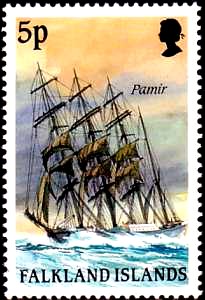
|
Maritime Topics On Stamps:
The Sinking of the "Pamir".
|
The Pamir Design Data :
- 1905 built by Blohm & Voss in Hamburg
- 1951 rebuilding, equipped with an Auxiliary Engine of 900 PS
- Length 114,5 m Width 14,1 m
- Draught 7,26 m
- Steel hull so-called Three- Island- vessel
- Steeldecks and 4 Steelmasts
- Rig whipped as a four-masted barque
- The main mast height above the deck 51,2 m
- GT after rebuilding 3.102,87
- NT after rebuilding 2.509,27
- Tdw (tons dead weight) 4.106
- Carried 32 Sails with a total of 3.600 m2 (square meter) sail area
- Max speed under sails 13,5 kn, max. 16 kn
- Crew 33 Men, when used as sail training vessel 86 Men
- 1957 sunk by hurricane "Carrie" south of the Azoren
|

|
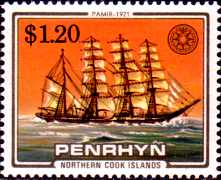
|
On the 18. of October 1905 the shipping company F. Laeisz put the "Pamir" in commission.
The ship was servicing in the nitride or potassium shipping to South America and rounded Cape Horn 18 times.
When the First World War began, the ship could not safely reach Germany, and so it dropped anchor on
the roadstead of Santa Cruz. Only in 1921 the potassium was discharged in Hamburg, and the boat was handed over
to Italy as part of the post-war reparation payments. But Italy did not have a crew to run a tall ship, and the "Pamir"
was laid up in the Golf of Naples.
|
In 1924 the shipping company Laeisz succeeded in buying back the "Pamir" for 7.000 pounds Sterling.
She was again put into the potassium shipping to South America. However this business was no longer profitable,
as the Europeans succeeded in making nitrous fertilizer themselves. In 1931 the "Pamir" was sold to the Finnish ship
owner Erikson.
Now the ship was put to servicing the wheat shipping from Australia to Europe. The "Pamir" participated in
seven wheat races and won the 1932 race. When World War II broke out, the ship was first laid off in Sweden,
then in 1940 chartered to Argentina and used to transport Guano between the Seychelles islands and New Zealand.
In 1942 she was confiscated in New Zealand and sailed under the Dutch flag until 1948. This included voyages to
the USA and wool transport from New Zealand to the UK.
|
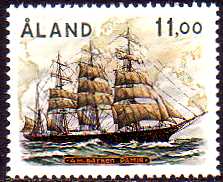
|

|
In 1948 the "Pamir" was given back to her Finnish owner, did a few voyages in the wool business, and was then
used as a depot vessel in Penarth, Wales. In 1950 a Belgian break up company bought her together with its sister
ship "Passat".
Virtually in the last minute the ship owner Schliewen bought both ships back in 1951and had them rebuilt into
training vessels. However he got into financial trouble and therefore 40 German ship owners established a
"Stiftung Pamir und Passat" and took over both ships. The boats were now sailing between Buenos Aires and
Hamburg, carrying wheat, but were primarily looked upon as training boats for
about 50 cadets each at a time.
|
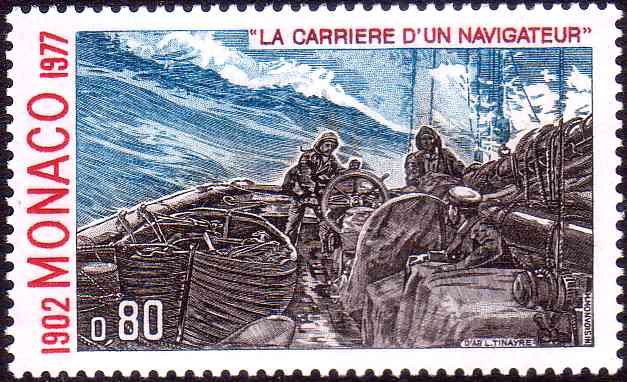
| |
On the 11th of August, 1957, the "Pamir" took to the sea for its homebound sail from Buenos Aires to Hamburg.
In her four holds and her deep tank she had loaded bulk barley, which was then covered with a few layers barley
in sacks. The ship had in its holds under deck fore-and-aft bulkheads, to prevent loose loads from moving around.
At the time the "Pamir" was loaded, the port workers went on strike, and therefore the officers on the "Pamir"
had the apprentices trim the load. This meant working in a dense cloud of barley dust to distribute the
incoming "rain" of barley seeds into the edges of the storage holds.
|
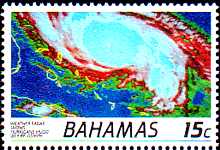
|
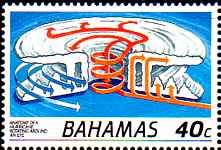
|
In the Atlantic or the Carribean the tropical cyclones are called hurricanes. A clerk sitting in his safe office all day
a storm becomes a hurricane, when its wind velocity reaches the strength of a hurricane, which is Beaufort 12.
Out on the ocean a hurricane is nothing less than howling gusts with more than 120 km/hour, at times up to 200 km/h,
in extreme situations even more.
On the two stamps you see a picture of the hurricane clouds on the left hand side, and on the right hand side the
inner workings of such a storm. In the year 1957 the "Pamir" got into the center of hurricane "Carrie"; she
capsized and sank. Of the 86 crew members 80 died, only six could be rescued.
|

|

|
Since nobody of the ship's officers in charge survived, nobody knows, when the "Pamir" got note about the
hurricane "Carrie" and why she sailed almost dead center into the hurricane's eye. From the testimony of the
saved sailors follows, that too many sails were still up on their yards, until the ship capsized.
Possibly the ship leadership might have tried to sail away and escape from the hurricane.
Unfortunately this did not work out, since the hurricane, opposite to all meteorological rules, changed its course
several times, as if it was chasing the "Pamir".
It was the 21. of September 1957 at about 9 o'clock in the morning, when the "Pamir" got into the hurricane
whirls of "Carrie".
Since there was extremely high pressure on the sails, but they simply did not drop. The men threw off the
sheets and tried to cut off the sails from the yards with knives.
The "Pamir" heeled heavily and did not even come up again, when all the sails were torn to pieces and blown away.
|
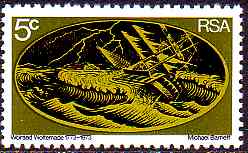
|
The wind velocity was about 130 km/h and the heavy seas were 12 to 14 meters high.
The whole port side of the ship was under the water and the yard arms dipped into the high going seas.
At about 11 o'clock the "Pamir" sent SOS, was heeling at about 45 degrees heel angle and reported,
that it was taking in water. Between 12 und 13 o'clock she capsized, and for a short period of time she lay flat
in the turbulent sea. Then the keel turned over, but the boat floated for another 20 to 30 minutes.
When she sank, a yellow fountain sprang out of the keel with a yelling whistle.
|
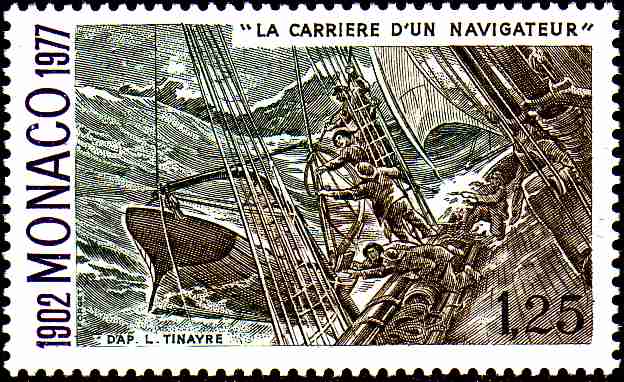
|
When the "Pamir" was still under sails dashing through the water in a heavy port sloping position, all the life boats
on the port side were simply torn off and crashed to pieces. And as the ship was increasingly more running on her
left hand side, the starboard life boats could no longer be dropped down onto the water.
Almost all of the crew jumped into the water, when the ship capsized, and tried to swim away from her.
They held on to pieces of wood floating around. The men formed groups helping each other in the howling hurricane.
Meanwhile the biggest search began, which has ever been staged to rescue castaways.
78 ships from 13 countries and 11 airplanes searched 7 days for survivors.
|

|

|
Two torn off but heavily damaged life boats drifted in the water, flooded, one of them keel up. One boat was reached
by 10, the other one by 22 men. In the boats they had to suffer under extreme thirst, since they had swallowed a
lot of salt water and the barrels with drinking water were washed away. Some drank their own urine, some
chewed on golf herbs. One man who tried to cut himself with a knife and drink his own blood was hindered
by the comrades. Some others drank salt water, began to hallucinate and left the boat.
Because the boats were totally filled with water, they sat in water up to their chests and they froze
terribly in spite of the 28°C temperature of the water.
They also saw searching ships a few times and air planes, but they did not discover them.
The flooded wooden life boats actually swam in the water and not on the water. Therefore they put up an
auxiliary mast-like structure with cloth pieces on it in both boats. But the totally exhausted sailors died one after another.
|
|
Two days after the sinking of the "Pamir" the 10-men-life boat was found by the American cargo ship "Sax",
with 5 men on board. One day later the last survivor of the 22-men boat was taken in by the US Coast
Guard boat "Absecon". The searching ships found many wreck pieces and life vests, in which traces
from human bodies could be identified. The six survivors confirmed that they had seen many sharks around their boats.
|
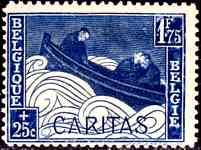
|
|
The Sinking of the "Pamir" has been affected by a few cardinal mistakes and omissions. The Sea Court
raised some severe questions to the captain and the owners.
|

|
- There was still one third of the ship's sail area up,
while the wind speed had already reached 10 Beaufort and pressed the ship on her port side.
In such a heavy storm you must drop one sail after another as fast as you can, to avoid too much heeling over.
- Next the barley load has probably set and compacted itself somewhat, creating cavities along corners of the holds.
It likely slid into these cavities, as the list and the stomping movement of the ship increased with the increasing storm.
Therefore the load slid into the same imbalance, which caused the ship to continue listing, even after all sails had
been torn and ripped off. The Sea Court concluded, that it had been an accident due to loss of stability, caused by the
misplacement of the load to one side.
- The "Pamir" did have a deep tank to improve the stability. Such a rank can be flooded with water to lower the
center of gravity. It must be closed of course to keep the water symmetrically along the center line of the hull.
Fact is, that this deep tank was filled with light weight barley, such that water could not be used to stabilize the ship.
If it was closed at all nobody knows.
- The ship was not prepared for the storm in time. In other words, the ship was not in the storm lockup condition,
when the storm hit. This lockup condition includes closing up all openings with steel plates and additional tarpaulins,
such as doors, bullies, skylights, vents,. Bulkheads will be closed too.
- The Captain was substituting only, he was not particularly familiar with the "Pamir".
- The maritime court explicitly denied to call it "an act of God", the accident had been avoidable.
|
|
The lawyers of the affected families and the expert reached a different result:
|
- The ship's hull was damaged, and therefore took in increasingly more water.
- The damaging power of a hurricane is much larger than assumed by the Maritime court, in particular in the
tremendous gusts.
-
The trace of the hurricane "Carrie "was insane, it followed the "Pamir" with abnormal structure "as if directed by
the devil and left no escape for her."
- The lawyers stated, "... that the handling of the sails and the sailor-like behavior of the captain before and
during the hurricane followed accepted nautical and meteorological rules, especially in view of the number of sails,
with which they tried to escape from the hurricane.
|

| |
This page of "Maritime Topics onStamps" can only describe the two contradictory points of view.
Who is interested in the full available detail about the sinking should study the 2 books and the report in Wikipedia,
look further down where the references are listed
|
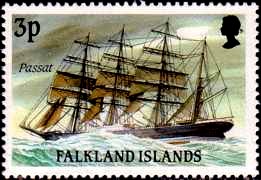
|
Only a few weeks after the sinking of the "Pamir" her sister ship "Passat", homeward bound from Montevideo,
survived a heavy storm only by a tiny margin. She got into a hurricane southwest of the Biscaya, which she had to
heave four days . Her load of barley did slide and she got into a port side list position. Different from the "Pamir" however
the "Passat" could compensate for it with flooding of the starboard deep tank, among other measures.
| |
The ship did not capsize and did not sink.
With about 50-55 degrees list they sailed into Lisboa harbor. After they corrected the barley load again
the "Passat" sailed with itself on to Hamburg.
|

|
Conclusions from the disaster:
The idea that young cadets must be trained on a Sailing vessel was dropped.
The training vessel "Passat" was decommissioned.
The Cork life vests (see the meter postage stamp above) used on the "Pamir" were substituted by vests,
which would even keep a sleeping or unconscious person in a position with the chest up and the head above the water.
The whole subject of having life boats, how to keep them, launch them and survive in them under extremely
difficult situations was revisited.
|
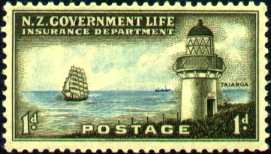
|
Sources:
J. Brennecke, K-O. Dummer, Viermastbark Pamir, ihr Schicksal im Zentrum des Hurrikans "Carrie",
Koehlers Verlagsgesellschaft
H. Willner, Pamir, ihr Untergang und die Irrtümer des Seeamtes, Verlag E.S. Mittler
Wikipedia Internet Encyclopedia
|
The German Public Television broadcasted a two-part movie on the sinking of the "Pamir" in November 2006 .
One of the survivors however testified, that this movie has nothing at all to do with reality.
For someone, who is not personally involved, it is incomprehensible, why the captain was so grossly portrayed
as a stubborn dummy and loser, and his wife as adulteress.
This negative picture does not give justice to the memory of the deceased.
|
|